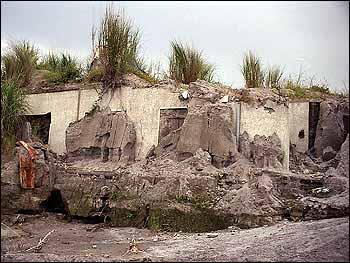On the night of September 22, 1994, a river of rock returned with a
vengeance to the Filipino village of San Antonio. The villagers had seen their
first "lahar" just three years before when Mount Pinatubo erupted for
the first time in centuries. These raging slurries of volcanic rock and ash and
water, powered by torrential summer rains and typhoons, sliced roads, buried
villages, and covered farmland beneath thick layers of volcanic rubble.
The lahars seemed to diminish a year after the 1991 eruption, and people
returned to the village. But in the summer of 1994, high up the river valley
that runs down the side of Mt. Pinatubo toward San Antonio, a lahar cut off a
segment of the Pasig-Potrero River behind a dam of loose volcanic debris. A lake
began to form behind this dam as the rains fell on the east side of the volcano.
On September 22, after a moderate rain, the swollen lake finally burst the dam
and tore down the valley toward San Antonio.
When the villagers heard the rumbling of tons of rock and water, they rushed
to higher ground or climbed onto their rooftops. In the dark they could only
watch helplessly as the lahar spread through the village. Many homes were
buried up to their rooftops. Two dozen people in the path of the lahar never
made it to safety.
The explosion of Mt. Pinatubo on June 15, 1991, just 60 miles northwest of
Manila, was the world’s largest volcanic eruption in nearly 80 years. Due
to active monitoring of the volcano by scientists and warnings of an impending
eruption, only a few hundred people died during the main eruption. Most
casualties were caused by the collapse of buildings under the weight of
rain-soaked ash and the lahars spawned by the eruption.
|
|

Mt. Pinatubo is part of a chain of
major volcanoes in the Philippines. Its eruption in June 1991 was the world’s largest in nearly 80 years. The most
recent Philippine volcano to erupt was Mayon, in February 2000.
|

But the hazards posed by Mt. Pinatubo continue to this day, even though the
volcano has remained quiet since 1991. Volcanologists estimate that damaging
lahar flows may continue for another 10 years. More than 5 cubic kilometers (1
cubic mile) of volcanic ash and debris were deposited on the slopes around Mt.
Pinatubo. Entire river valleys were filled. Each year part of that new
volcanic layer is sent churning downslope by the heavy monsoon rains and
typhoons that hit central Luzon between June and October. Scientists estimate
that as much as 60 percent of the rocky debris from the eruption will eventually
erode into the lowlands around the volcano. That’s enough sediment to cover
the state of Rhode Island in a layer 1 meter deep.
Monitoring the continuing dangers from lahars is difficult. Whereas the onset
of a volcanic eruption can be monitored by observing a relatively small area,
lahars can cover tens of square kilometers and are a moving hazard that changes
location and shape with each heavy rainfall. Volcanologists are now turning to
remote-sensing observations from spacecraft and airplanes to track this dynamic
hazard.
 Topographic Volcano Maps by Remote Sensing Topographic Volcano Maps by Remote Sensing
|
|
Volcanic
rubble and ash mixed with torrential rain produces devastating
lahars that can bury villages, roads, and bridges. This house in the
Pasig-Potrero river valley east of Mt. Pinatubo was completely buried in
mudflows, which are now being eroded away. (Photo by Peter Mouginis-Mark,
University of Hawaii at Manoa) |

